Rock & Roll, Heart & Arrow
Music and design go together, with London’s Danny George Wilson and One Lucky Guitar.
In our early days, we tried just about anything to get the word out and create awareness amongst musicians and record labels about One Lucky Guitar—a lil design shop in Fort Wayne, Indiana, aspiring to be a lil music design shop in Fort Wayne, Indiana. We spent weeks in Nashville, attended conferences and trade shows, handed out poster tubes at SXSW, ran adverts in music magazines and mailed sample after sample after sample to indie labels, bands, managers and anyone with an address we could find. When you added it all up, it almost worked—almost. What I found out then, and what’s still true today, is that no matter how great your design work is, no matter how many awards you win, it’s really all about personal relationships built on trust, a real plan for delivering results, and a common passion. And hey, is there a more wondrous common passion than music? I will tell you that there is not.
A short anecdote: A few years ago, I was at a meeting at John Prine’s Oh Boy Records offices in Nashville. The meeting was over the lunch hour, and mail was delivered while we were camped out around the conference room table. The mailman had two tubs, both of which he dumped out in front of us. The first tub was full to the brim with padded envelopes containing demo CDs—thirty or forty “next John Prines” on a random Thursday in September. The other tub was full with poster tubes, rolling and bouncing about the table and onto the floor. The return addresses? Seattle. Minneapolis. Chicago. New York City. Portland. A couple dozen incredible designers, willing to do incredible work for free—simply because of how much Mr. Prine’s music meant to their own lives. And this happened every day.
Over the next couple of years, and while the tubes rolled in to Oh Boy day after day, we designed a half dozen or so album covers (as well as t-shirts, interactive, tour merch, posters and trade ads) for the label, for artists like John, Todd Snider (those are my feet on his album cover!), Steve Goodman, Dan Reeder and more—folks we listened to all the time, folks whose songs melted our hearts, folks who just a couple years before we had dreamt of designing for. All of this, simply because we connected with the Oh Boy team. We got what they got. We were bonded, we had each other’s backs. We were able to visually convey their sound, their core, their (dare I say it) soul, in a way that meant more. It’s like Wilson Pickett sang: ninety-nine and one-half won’t do. That’s the kind of thing that’s hard to fit in a poster tube.
Back to the story at hand. One of the tactics we used to create awareness about OLG was to run ads in the late, great alt-country magazine, No Depression. (ND has since ceased publishing, but still runs a great website.) Our No Depression ad, ran in 2004, led to some terrific relationships with the ND team, and two great leads. The first was Smithsonian Folkways Recordings, the record label of, you guessed it, the Smithsonian. Yes, the one in D.C. We really, really hit it off with SFR’s Mark Gustafson, and ended up working on more than 100 projects for the label, from t-shirts to point-of-purchase to album art to limited edition letterpress posters. A couple of those projects buzzed pretty close to the sun: first, in Bob Dylan’s memoir Chronicles, Volume One, Mr. Dylan went on and on about Folkways. Using some key quotes from that (incredibly amazing) book, we built a campaign promoting the Folkways records Bob spotlighted in his book; a campaign which eventually had to be signed off on by “Bob’s people.” Bob’s people! We also worked on the album art and marketing campaign for Can’t Start a Fire, the Pete Seeger / Folkways collection that gathered the songs that Bruce Springsteen (Bruce Springsteen!) had covered for The Seeger Sessions.
From the No Depression ad, though, I also received an email from a songwriter in London who had recorded an acoustic, singer-songwriter record on his front porch, in between albums for his main project—alt-country rock band Grand Drive—and was looking for a sleeve design.
And that’s who this case study is really about. Danny George Wilson, my best friend I’ve never met.
 Danny and I were gonna become fast friends one way or another. It turned out Grand Drive had played SXSW that year, and I arrived at Buffalo Billiards just after their set. It was likely Danny and I had stood at the same bar in one of those will-they-or-won’t-they-meet moments from the movies. Perhaps we literally did bump into each other that night, two guys a long way from home, following the sound, drinking an ice cold Lone Star and dreaming of an Old Speckled Hen instead.
Danny and I were gonna become fast friends one way or another. It turned out Grand Drive had played SXSW that year, and I arrived at Buffalo Billiards just after their set. It was likely Danny and I had stood at the same bar in one of those will-they-or-won’t-they-meet moments from the movies. Perhaps we literally did bump into each other that night, two guys a long way from home, following the sound, drinking an ice cold Lone Star and dreaming of an Old Speckled Hen instead.
In his email, Danny had originally asked about rates and how the creative process might look from such a long distance away, but our correspondence quickly made its way to the story of this music, its inspiration and its message. It turned out Danny and I had a lot in common—specifically the mid-70s to early-80s music of Bruce Springsteen, an era of music that had touched both of our souls at a formative time. Danny sent the record over via air post and when I played it the first time, I just shook my head at how lucky I was to get to be a part of the project—the music was tremendous, beautiful, a bit sad, a bit nostalgic, but ultimately colored with optimism. “A lucky man, falling on his feet. This life is just stories waiting to unfold.”
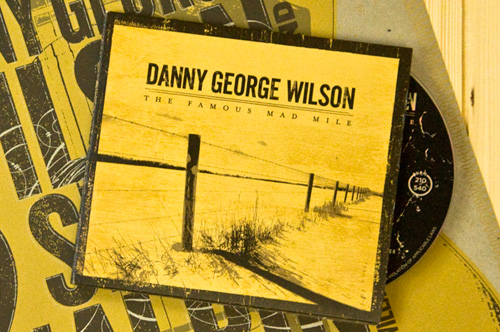
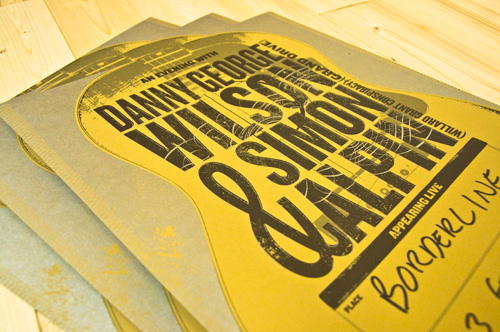 The album was named The Famous Mad Mile and would be released on Paris-based Fargo Records. I played the music for my friend, photographer Tony Byrd, and we set out to capture the sound of the album in photos. In the rural farmlands of Northeast Indiana, we found the fenced stretches of highway where racing in the street might meet a long, lonely walk home. We eventually printed ‘promo copy’ sleeves on letterpress with our trusted partners at Courier Printing in Grabill, Indiana, and followed up with the full album art and lyric book, tour posters, merch design and more. The Famous Mad Mile received deservedly raving reviews, and I still fondly recall seeing the album art in the ‘New in Americana’ section of Uncut, one of my favorite magazines. Life was funny.
The album was named The Famous Mad Mile and would be released on Paris-based Fargo Records. I played the music for my friend, photographer Tony Byrd, and we set out to capture the sound of the album in photos. In the rural farmlands of Northeast Indiana, we found the fenced stretches of highway where racing in the street might meet a long, lonely walk home. We eventually printed ‘promo copy’ sleeves on letterpress with our trusted partners at Courier Printing in Grabill, Indiana, and followed up with the full album art and lyric book, tour posters, merch design and more. The Famous Mad Mile received deservedly raving reviews, and I still fondly recall seeing the album art in the ‘New in Americana’ section of Uncut, one of my favorite magazines. Life was funny.
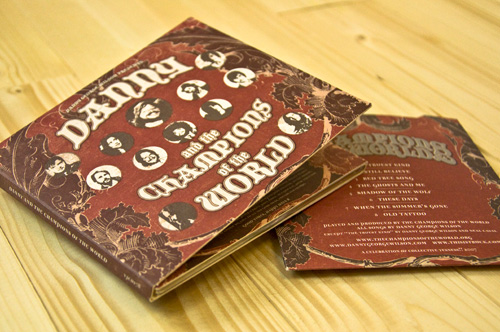 A year later, Danny called up about his newest project—a cosmic collective known as Danny & The Champions of the World. Danny had recorded his album in a giant barn with members of Electric Soft Parade, Goldrush, Brakes and more, and their Rolling Thunder-esque live performances featured an exuberant everyone-on-stage doing everything-at-once approach to chamber/folk/pop music. Their debut, self-titled album is an epic, sprawling work and home to some of Danny’s finest, most cathartic anthems. Danny had sent over some ideas for a Fairport/Dead/Fillmore visual approach, and it worked—we wanted to convey the loose, sadly beautiful, Ronnie Lane-esque sound this collective was pulling together. We once again worked with Courier Printing on limited edition, letterpress sleeves before tackling the full digipack, single sleeve and support materials.
A year later, Danny called up about his newest project—a cosmic collective known as Danny & The Champions of the World. Danny had recorded his album in a giant barn with members of Electric Soft Parade, Goldrush, Brakes and more, and their Rolling Thunder-esque live performances featured an exuberant everyone-on-stage doing everything-at-once approach to chamber/folk/pop music. Their debut, self-titled album is an epic, sprawling work and home to some of Danny’s finest, most cathartic anthems. Danny had sent over some ideas for a Fairport/Dead/Fillmore visual approach, and it worked—we wanted to convey the loose, sadly beautiful, Ronnie Lane-esque sound this collective was pulling together. We once again worked with Courier Printing on limited edition, letterpress sleeves before tackling the full digipack, single sleeve and support materials.
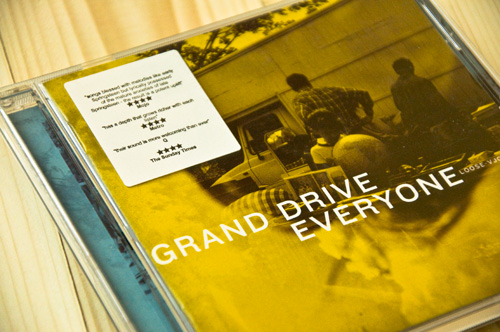
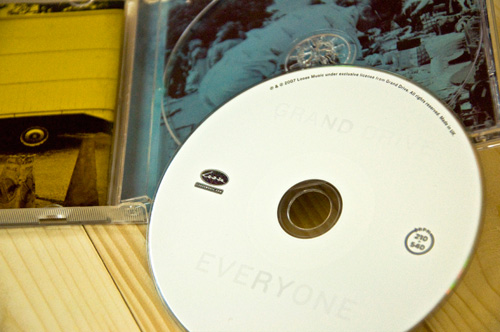 Soon thereafter, Danny asked if we’d work on the artwork for Everyone, the final album from Grand Drive, the band he had started a decade earlier with his brother, Julian. We were thrilled; the album is terrific, from top to bottom. For this record, which came out on London’s excellent Loose Records, we worked with photographs by Ben Graville, who had captured the mid-90s ‘car boot sale’ phenomenon in striking black & white images. We pushed a bold, complementary color palette and used a spot-on-spot UV varnish on the disc face—making this one of my favorite design projects. [Bringing things full circle, Danny and Julian later went back to the studio to record a reworking of Everyone’s awesome opening track, “The Skin You’re Living In,” for a Lutheran Hospital TV spot (we’d worked with Smithsonian Folkways on other spots in the campaign).]
Soon thereafter, Danny asked if we’d work on the artwork for Everyone, the final album from Grand Drive, the band he had started a decade earlier with his brother, Julian. We were thrilled; the album is terrific, from top to bottom. For this record, which came out on London’s excellent Loose Records, we worked with photographs by Ben Graville, who had captured the mid-90s ‘car boot sale’ phenomenon in striking black & white images. We pushed a bold, complementary color palette and used a spot-on-spot UV varnish on the disc face—making this one of my favorite design projects. [Bringing things full circle, Danny and Julian later went back to the studio to record a reworking of Everyone’s awesome opening track, “The Skin You’re Living In,” for a Lutheran Hospital TV spot (we’d worked with Smithsonian Folkways on other spots in the campaign).]
It’s worth noting at this point that when I say, “Danny called up about a new record”…well, that might be playing it down a bit. Fact is, we’d become brothers on different continents, or at least, the best pen pals still pen palling. We’re ten emails in before we talk about due dates and next steps—instead, we’re raving about new records, our all-time favorite shows, the songs and projects we’re working on, and how the bands—the Champs and the Luckys—are doing, and what the kids are up to. Danny in the inbox never brings me anything other than the widest grins.
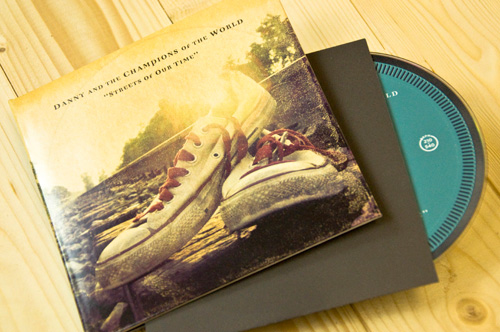
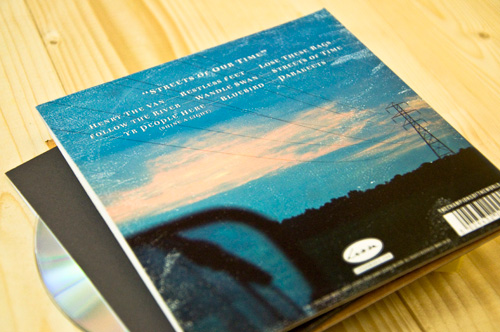 The Champs’ follow-up to the self-titled record was a more acoustic, pastoral album called The Streets of Our Time. It’s an amazing record that opens with “Henry the Van,” a song about, well, a van. Danny and his band had named their touring van “Henry,” and this song is about that vehicle finally giving up on the roadside outside Aberdeen. But, you know, like the best songs, it’s about a lot more than that. It’s about friendship, bands, love, strife & struggle and the way they can all come and go, and the preciousness of time, and the wonder of life, and of doing what you love, and maybe of growing up but not growing old. I’m not gonna lie, the first few times I heard this song it brought me to my knees. And that’s just the opening track.
The Champs’ follow-up to the self-titled record was a more acoustic, pastoral album called The Streets of Our Time. It’s an amazing record that opens with “Henry the Van,” a song about, well, a van. Danny and his band had named their touring van “Henry,” and this song is about that vehicle finally giving up on the roadside outside Aberdeen. But, you know, like the best songs, it’s about a lot more than that. It’s about friendship, bands, love, strife & struggle and the way they can all come and go, and the preciousness of time, and the wonder of life, and of doing what you love, and maybe of growing up but not growing old. I’m not gonna lie, the first few times I heard this song it brought me to my knees. And that’s just the opening track.
For the art on this one, my son—Henry!—and I took some old sneakers out on a photoshoot on the tracks to capture “Restless Feet,” and then later borrowed my co-worker’s band’s (Metavari) own touring van, an aged Chevrolet Beauville, and shot photos in the rural landscape in New Haven, Indiana to capture “Henry the Van.” (Those sneakers have now been used on album art projects for both Danny AND the band Marah, which I have to admit is rather awesome. Oh, and we had a copy of Metavari’s record waiting backstage for the Champs at the album release show, as a thank-you, and to tie it all together.)
Uncut. Q. Mojo. The Independent. Telegraph. The BBC. Americana UK. On and on and on they all go, every album receiving an even more glowing review than the last.
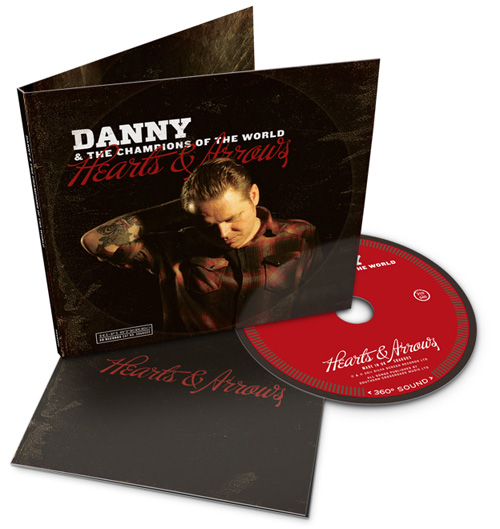 Which brings us to the present day. When Danny reached out about Hearts & Arrows, he said he’d made a “guitar record” and was terribly excited about it. At the time, the album was in the mixing stage with Ted Hutt of Gaslight Anthem fame. From the opening notes of “Ghosts in the Wire,” it’s apparent that this is a whole new band with a whole new approach. “Never let the truth get in the way of your story.” In short, it’s the album of the summer, an album impossible to listen to with the windows closed, an album to pump your fists to and blow your speakers out with. The driving rock songs of Hearts & Arrows bridge the years between Darkness on the Edge of Town and The River and are loud, anthemic and no-nonsense. As such, we designed an album that would look exactly like that. Bleecker Street Records, 1979. I was thrilled when Danny reported that the great Tom Sheehan had done all of the photography for the project. From Glastonbury to The Borderline, Danny and the Champs are touring the album this summer and fall—an album, and shows, which have received rapturous praise. Next up? Working on the art for the vinyl release.
Which brings us to the present day. When Danny reached out about Hearts & Arrows, he said he’d made a “guitar record” and was terribly excited about it. At the time, the album was in the mixing stage with Ted Hutt of Gaslight Anthem fame. From the opening notes of “Ghosts in the Wire,” it’s apparent that this is a whole new band with a whole new approach. “Never let the truth get in the way of your story.” In short, it’s the album of the summer, an album impossible to listen to with the windows closed, an album to pump your fists to and blow your speakers out with. The driving rock songs of Hearts & Arrows bridge the years between Darkness on the Edge of Town and The River and are loud, anthemic and no-nonsense. As such, we designed an album that would look exactly like that. Bleecker Street Records, 1979. I was thrilled when Danny reported that the great Tom Sheehan had done all of the photography for the project. From Glastonbury to The Borderline, Danny and the Champs are touring the album this summer and fall—an album, and shows, which have received rapturous praise. Next up? Working on the art for the vinyl release.
Here’s the deal. Danny’s songs, for me, have always arrived right when I needed them most. I think he’s one of the finest songwriters working today—perfectly capturing the wistfulness of growing up, reflections without regret. He writes about relationships—love, friendship, brotherhood and being in a band—better than just about anyone else. The Champs are the band I always kinda wished my Trainhoppers could have been, and Danny’s songs are the ones I kinda wished we’d written.
These songs make living life feel bigger. The past feels more epic. The future feels more full with opportunity. And the present feels more vital than ever.
That’s a true gift, a gift for each and every one of us that’s listening. Or, as Danny might sing, “Boys, it’s good to be gone, but it sure is better coming home.”
Download THE DIAL EP, featuring the following songs:
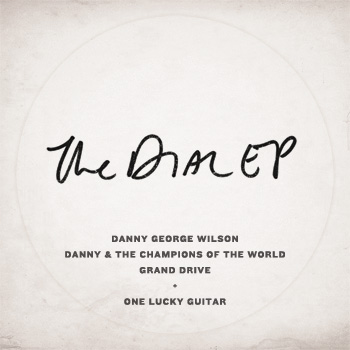 1. “Fishing Line” ~ Danny George Wilson, from The Famous Mad Mile, 2005
1. “Fishing Line” ~ Danny George Wilson, from The Famous Mad Mile, 2005
2. “Red Tree Song” ~ Danny & The Champions of the World, from Danny & The Champions of the World, 2008
3. “Restless Feet” ~ Danny & The Champions of the World, from The Streets of Our Time, 2009
4. “Heart & Arrow” ~ Danny & The Champions of the World, from Hearts & Arrows, 2011
5. “Be Lucky” ~ Grand Drive, from Everyone, 2007
Note: Speaking of gifts, how cool is it that Danny has offered up the free MP3s above? Welcome to the five best songs you’ll hear all year.
During the summer of 2011, the Sony/PIAS distribution warehouse for Danny’s label (and scores of other indie labels from around the world) was burned to the ground in the London riots. You can support Danny and Loose Records by picking up his records at the Loose shop, or—sans packaging—on iTunes. And we hope you will.
A conversation with Danny George Wilson and Matt Kelley.
Matt Kelley: Danny, there’s a great moment in the movie School of Rock where Jack Black’s character, Dewey Finn, says, “Putting on a great show is the most important thing you can do. One great rock show can change the world!” The movie is a comedy, but Dewey’s reverence for rock & roll is a beautiful, true thing. And I think he’s right.
We’ve talked before about how when I saw Bruce Springsteen on a whim in Indianapolis as a college freshman (December 5, 1992—on the Lucky Town tour!), well, it simply changed my life. The passion, courage, conviction and joy with which Bruce communicated with his audience, his band…it was just blinding to me. That magic & ministry of rock & roll music took my breath away and sent my imagination on a journey that, thankfully, has never stopped. I changed my major and everything else, and would be leading a completely different—and achingly boring—life right now if I hadn’t gone to that show.
Tell me about your favorite concert, either one you’ve attended, one you’ve heard on bootleg, and maybe even one you’ve played.
Danny George Wilson: Hey Matt! I love that School of Rock film too—there’s often beautiful, life-affirming stuff in supposedly ‘light’ films that really catches you… There’s great stuff in movies like Breaking Away, Field of Dreams, The Princess Bride (we got the title for the second Grand Drive album from the William Goldman book… ‘A Tale of True Love & High Adventure’), Stand by Me, The Natural…… love’ em.
I love that a show had the power to change your tracks—I totally identify with that—I often find myself almost fighting back tears at shows…not especially for the lyrics of a particular song but for the romance, the passion, the shared experience—hell, it happens every now and then during our own shows too! Jeez, it’s so easy to sound evangelical about all of this but I guess it’s just the truth.
I’ve been to so many incredible shows, but the ones that stick in my mind as particularly influential on my life are the ones that I went to as a teenager with my old man….
One in particular was in France, I was about 14 years old and on a camping trip with my folks. My Dad found out that ‘The Fabulous Thunderbirds’ were playing about 30k away—he’d been playing petanque with some French guys all day and had been testing out the local firewater so my Mum had a firm hold on the car keys… so we set off hitchhiking—got some cool lift in a classic ‘40’s Citroen! It wasn’t necessarily the music alone but it was the romance, the road, the flying by the seat of your pants of it all. I guess that night had a big influence on me—the romance, the road and flying by the seat of your pants have become pretty much my life…
MK: Ah, man, that’s too wonderful. My dad played me Don Williams and “Killing Me Softly.” I learned to love ’em much later in life, but still…I’m jealous! Alright, so, it’s no secret that we both love album art and poster design. I still remember the adrenaline racing through my brain the first time I saw the Blue Note Records book or walked into Hatch Show Print. I wondered if you had any favorite album covers—visuals that so quintessentially capture the record that it wouldn’t be the same without them?
DGW: Wow, I remember getting a hold of the Blue Note sleeves book—genius. There was a companion book of classic blues LP covers too that was amazing—has that stuff ever been bettered? I doubt it. I was lucky enough to get to go to the Hatch Show Print shop in Nashville a few years back—it’s a beautiful place, a beautiful thing. It’s funny but the only thing that disappoints me about the digitalization of music, way more than the sound quality, is that I feel like we’re losing the link between the music and the art and the artefacts that accompany—I’m a huge fan of LP’s, and the posters, postcards and foldouts that often came with them. Having said that, the trend for incredible show posters has grown and that’s a great thing—I love that you can buy a real piece of art at a show these days—we’re doing some great ones at the moment designed and screen printed by Scarlett Rickard here in the UK. It’s cool that vinyl seems on the rise again…
It’s probably obvious in a way but the LP sleeve that really sticks out for me is Springsteen’s Born to Run—it perfectly captures the brotherhood and wide eyed beauty contained within the grooves… Darkness on the Edge of Town is a great sleeve too—you can see and feel the hunger and the hurt in his eyes.
I love what Smithsonian Folkways, Fonotone, Dust to Digital and Revenant do—beautiful…
MK: Yeah, for me, I mean—it’s hard for me to separate great album art from great albums, they just each make each other so much stronger. You’re so right and it’s impossible to argue with Born to Run, which is perfect in every way. Having said that, unpolished is fine with me, too, and Paul Westerberg’s Stereo / Mono is just right.
As a guy who loves consistency and branding, in my formative years I really dug the way Blur and Pulp handled their mid-90s albums and related singles and EPs—the Parklife–The Great Escape–Blur and His n Hers–Different Class–This Is Hardcore eras—they really built a narrative and “campaigns” that were terrific at every touch. My teammates will kind of bust me up about this, but while I don’t love the albums so much, in those days I certainly appreciated what Pearl Jam was doing from a design standpoint—Versus, Vitalogy and especially No Code were all very ambitious and really brought the listener into the experience. There was something there you can’t recapture in a PDF that comes with an iTunes purchase.
I really ought to mention Paul Westerberg’s 14 Songs, too. From an art direction standpoint…I loved that typography, the style of the photography, the color palette, the paper and printing, everything about it. I loved his shoes, his gear, the way he held a cigarette. We’re about to kick off this really wild launch for a new company at work, and the photography and video will be directly inspired by this sleeve. (Don’t tell anyone.)
And yeah, man, you’re right about Smithsonian Folkways. I remember my mom getting me the Harry Smith box for Christmas one year. The design aesthetic of that really lit my imagination on fire. It was a real thrill to later get to work with those folks.
OK, so, I wanted to see if you might discuss some of the influences on your songwriting, which as I’ve indicated in the case study, I find brilliant. Such lyricism—e.g., “’Love’ is all that remains of an old tattoo.” Cinema, literature, other songwriters?
DGW: I was brought up in a house that would often shake to the sound of great rock and roll and soul music. My family is Australian and as a boy my Dad’s job at the family shop was to stock the jukebox with the hits—he seems to know every single doo wop, RnB and pop hit from the 50’s and there’s a sparkle in his eye when we talk about Dion and The Belmonts or Frankie Lymon. He saw Buddy Holly in ’58, The Everly Brothers… oh, everyone. I’m pretty much influenced by Hank Williams and Sam Cooke and everything inbetween and by all the other writers who have ever laid on their backs and marveled to the genius of Leiber and Stoller’s ‘Stand by Me’… You can always tell who they are.
Kerouac was a huge influence on me as a young man—On the Road was a window into a world that I wanted to be a part of—I never knew if it still existed and times are so different these days but I still hold the romance of life, the freedom of the road, brotherhood, the wind in your hair and true love as the dream, the goal, what it’s all about.
I really love reading Larry Brown’s books—I can read and re read them and always find more. My favourite recent book was called The Ballad of Trenchmouth Taggart by M Glenn Taylor—it’s a wonderful tale—would make a brilliant film. I’m reading Edward Bunker’s No Beast So Fierce at the moment—total classic.
MK: We’re both guys that took some risks and chased our dreams. What does it mean to you to have released your tenth record with Hearts & Arrows? Tell me about your journey, the evolution of your craft and the sacrifices and victories you’ve experienced along the way?
DGW: Crikey Matt! Firstly, it means everything to me that I have been given the opportunity to make records at all—it wasn’t something that even crossed our minds as teenagers—we just wanted to write songs and play in sweaty rock and roll clubs—wipe your feet on the way out. Our ambitions were all musical, the word ‘career’ didn’t pass our lips. We were obsessed with trying to write songs that someone could fall in love to, dance to or drink to—we wanted to write songs like Dan Penn or Smokey Robinson. It felt like a huge achievement to get booked into a place in the centre of town—when we first heard ourselves on the radio we danced in the street. At the time of the first Grand Drive recordings the scene in London was all about Britpop—being seen in the right places was super important, music career minded kids were moving to Camden town, the indie mecca, in their droves and were all throwing the right shapes, in the right threads to the right people—we on the other hand were staunchly ‘other’, obsessed with being ‘true’ to ourselves and a little cut off, albeit self-imposed. We were never flavor of the month, never cool and it set us in good stead…the long road.
I love playing and writing now more than ever, I feel happy in my 38 year old skin and I feel like I can hit the ball pretty sweetly. I don’t feel that that there have been sacrifices for me but I’d be kidding myself if I was to say that my choices and dreams haven’t had a big impact on my wife and my kids—sometimes good, sometimes bad, welcome and imposed. It’s something I write about in the song “Streets of Time”—I say “I know I gambled with your faith in me, pushed it to the edge, I took your love for granted, like it would never end” and it’s painfully true and sometimes painful to sing. The fact that people choose to listen to it at home or come out to see it sung is the victory, and one that I won’t ever take for granted and I’ll never forget the taste.
MK: Damn. I try not to be too much of a fanboy with you and other songwriting heroes I’ve been fortunate to meet or work with, guys like Tim Rogers and Ike Reilly. So I try not to ask about the songs. “Hey man, what’s that mean?!” I guess that’s the genius of this conversation…hoping you’ll tell me about them instead! I’ll tell you, the first time I heard “Streets of Time” (and “Henry’s Van” off the same record), it just brought me to my knees. Those are incredible, incredible songs. You captured those feelings so perfectly, a guy like me hears that and…I don’t know, I mean it’s life, and it’s life made so much richer and deeper and more real through the music. I love songs. They’re a treasure, and nobody can ever take ‘em away.
I think the first time I knew we were prolly blood brothers, and destined to do a lot of great work together, was when we bonded over Darkness on the Edge of Town. I loved the documentary and box set, The Promise, that Bruce released earlier this year to mark that album’s 30th-ish anniversary. The period footage and interviews were incredible, but the contemporary interviews gave it an entirely new dimension. One thing Bruce said in the doco really caught me: “More than famous, more than rich, more than happy, I wanted to be GREAT.” With those words as backdrop, you get to see how hard those guys worked on that record, never settling, never thinking that good enough was, well, good enough. I love that quote, and it perfectly sums up why I love that guy and his art. What’d you think of that project?
MK: Danny, few things would make me happier than to have you play a One Lucky Guitar presents… concert in Fort Wayne, Indiana. We’re gonna do that someday, right?





